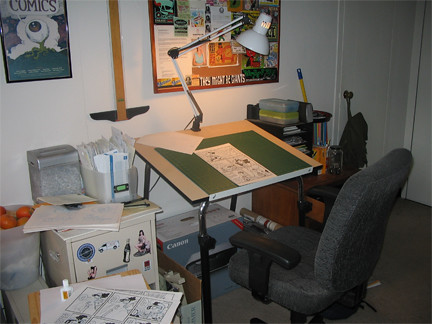
Comics: THE CLAWS COME OUT (due Nov. 2007 from IDW), various minicomics including "Thankless Job," "Hideous," "Abominable," "One Horse Town"
Website: www.lunchbreakcomics.com
Making comics since year of: 2002 maybe? It's hard to pinpoint exactly when I quit screwing around and got serious about it.
Art education/schools attended: No formal art training, but writing is an important part of making comics, too: I have a BA in English from Penn State.

Tools
Pencils: I sometimes do my penciling in a coffee shop, away from my studio, so anything that needs to be sharpened isn't a good option for me. Right now, I use a Koh-i-noor mechanical drafting pencil with Pentel .05 blue leads. The blue drops out when you adjust the threshold in Photoshop which is good because you don't need to erase your pencils that way. The bad part is that you CAN'T erase them very well, which can be a pain if you need to redraw a panel multiple times.
Pens: Micron 05 (or equivalent), Faber-Castell PITT artist (brush) pen, Uni-ball Micro for tiny details.
Paper: Canson 14" x 17" vellum-surfaced bristol, cut in half to make two 8 1/2" x 14" sheets (I draw my pages at 8" x 12"). Lots of people swear by Strathmore, but I like the Canson--it's a brighter white and has just enough "tooth" for my tastes.
Lettering: No one ever talks about Ames guides! I space my lines of text with an Ames guide, but I'm never too sure what to set the wheel at, so I use the fixed set of holes on the left-hand side. I do the finished lettering with a Micron 05, and a Penstix 0.7 mm drafting marker for bold text.
Color: Photoshop! I recently upgraded to CS for an illustration job, but I got along fine with version 5.0 and before that, the limited version that came free with my scanner.
Layout/ Composition: Nothing fancy--I make tiny (approx. 1" x 2") thumbnails in my sketchbook, on scratch paper, or wherever's handy. I find I spend too much time and energy on my layouts, it kills my desire to work on the actual page.
Tool timeline, starting from when you began drawing in any serious way until the present, and what spurred the changes: I went through a series of cheap felt-tip pens until I fell in love with the Fountain Pentel sometime in the 90's. It gave a nice variety of thin and thick(ish) lines that you don't normally get from most felt-tips. Eventually, they changed it from a cheap, disposable pen to a more expensive refillable model, which was okay except the refill cartridges were tough to find. So I switched to Microns, which are pretty ubiquitous and can still provide a good line variety if you know what you're doing.
What tools you'd never use, and why: I never say never, but I don't really have any interest in dipping a pen or brush into India ink ever again. The potential mess and the fear that I'm going to make a huge mistake really holds me back and keeps me from working as fast and spontaneous as I like.
And lastly, any advice you'd like to give: I enjoy reading about artists' tools as much as the next dude, but don't let anyone make you feel guilty for how you work. The results are all that matters, and odds are any shortcomings you may have are probably the result of your skill level rather than what kind of pen you use (at least, that's the case with me). No matter how weird or unorthodox your methods, I guarantee there's a professional artist out there doing great work with an even crazier way of working.
